This summer, Southampton’s no.1 striker, Danny Ings, departed from the Saints to join Aston Villa with his contract having been due to run out next summer. Some might have worried about Ralph Hasenhüttl’s forward options as he only had Ché Adams and Shane Long, while Chelsea loanee, Armando Broja, is still young and inexperienced.
When the Saints entered the market for a new striker, they quickly turned their eyes on Blackburn Rovers’ Adam Armstrong. The 24-year-old striker only cost €17.70m, which was a bargain. But, could Armstrong replace Ings and keep Southampton, who ended last season in 15th place, in the Premier League?
This tactical analysis is a scout report that details Armstrong’s role under Hasenhüttl’s tactics.
Although he was a scoring machine in the EFL Championship last season, he was a different type of player to Ings who offered the team more than just goals.
Interaction with teammates
Although some might think Armstrong was signed to be a poacher and great finisher like Ings, he’s more than that. Hasenhüttl’s football is physically, disciplinarily, and mentally demanding. Armstrong had good potential to fit all the requirements for being a key player of this club in the short term.
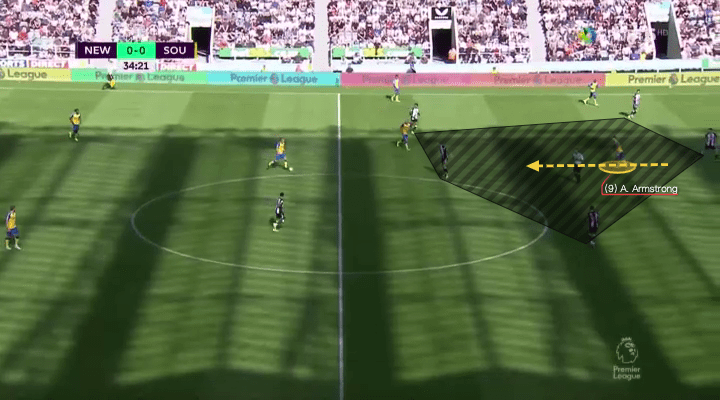
Armstrong’s style is dynamic as he can drop into spaces to receive. Hasenhüttl has a specific term named “red zone” in his playbook which refers to the spaces behind the opposition midfield. In his football, the attacking players must constantly occupy and use the “red zone” to open up the opposition.
We have already seen Armstrong exploiting the red zones for Southampton. In the first example, when his teammate was carrying the ball forward, the 24-year-old striker dropped behind the opposition midfield to receive. This opened a progressive option and allowed the team to break lines.
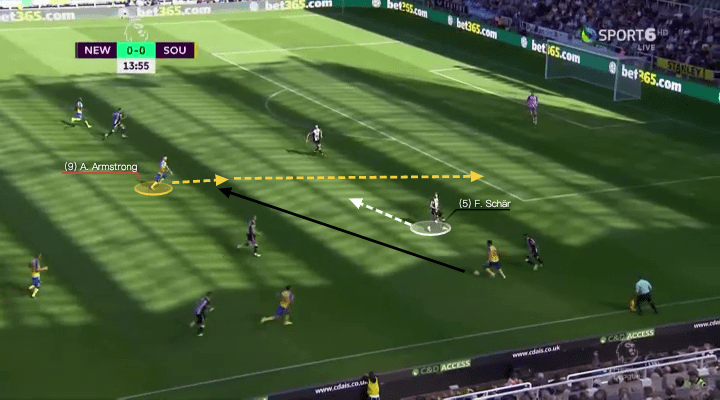
Armstrong is a player blessed with good physicality. He can sprint and accelerate in an instant to escape from the opponents. In the second image, Armstrong once again appeared in pockets of spaces between Newcastle United’s defence, offering a central passing option for the teammate on the flank.
Meanwhile, Armstrong also spotted that the Newcastle centre-back Fabian Schär must turn his body to face the centre. Therefore, he took a heavy touch and accelerated into space behind the defence when Schär was off balance. Within seconds, Southampton were attacking the penalty box.
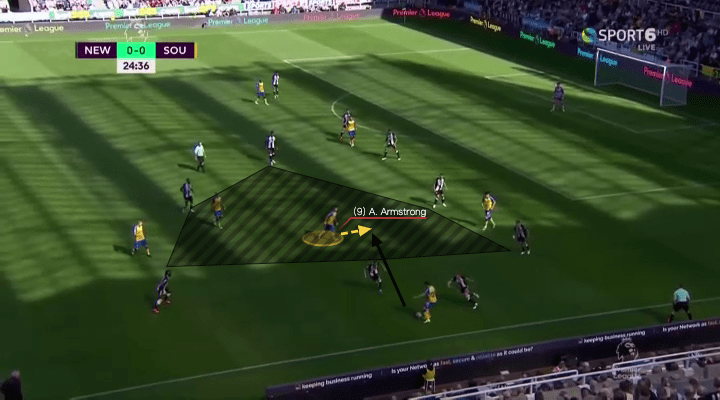
This is not Armstrong’s only solution, he is a dynamic player. In another instance, he was in the red zone again but this time, he did not burst forward as there was another Saints player in the channel. If he used the same technique, he would be running into traffic and crashing with his teammate.
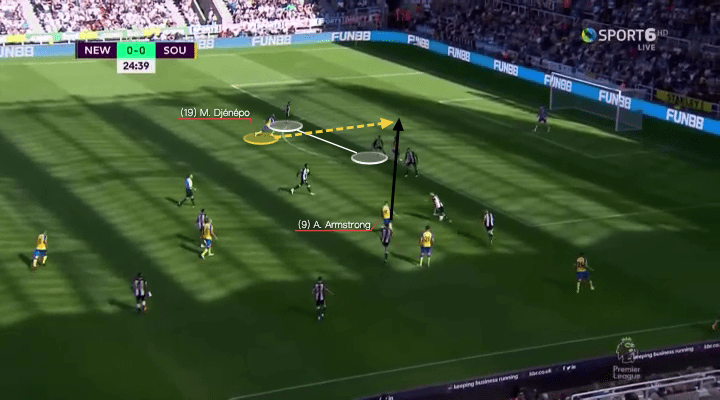
Therefore, Armstrong took a touch to control the ball, then continued with another touch to shift his playing angle. Now, he faced the centre and had a larger visible area, better information on the pitch was perceived.
That’s why he could spot the presence of Moussa Djenepo on the far side. The Mali international was speeding up to attack the far side gap and Armstrong neatly sliced the ball into his path, creating a goalscoring opportunity. It’s worth mentioning that Armstrong’s pass was from his left foot, showing that he’s good at using his weaker foot as well.
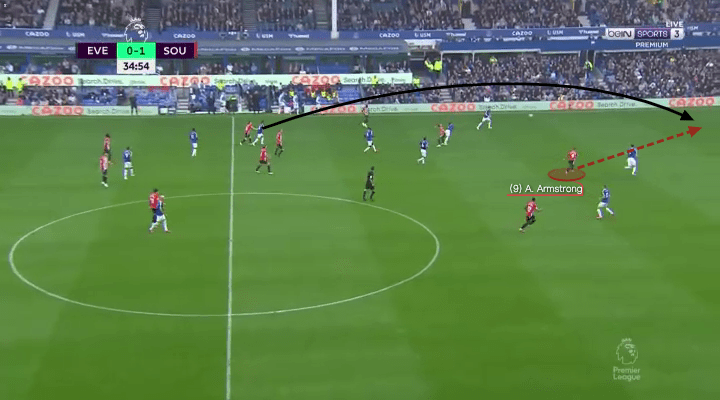
The examples so far have demonstrated Armstrong’s ability to operate in spaces between opposition lines but Hasenhüttl’s football requires more than that. Another principle of play is to search for attacking depth, which means Southampton’s strikers should constantly make runs into spaces behind to engage the opposition. Armstrong can carry out this tactical duty as well.
This screenshot from the game against Everton shows a method of Southampton’s attack. They always ping the ball into outside spaces behind the opposition defence and let the strikers chase. It was Armstrong who made the run here.
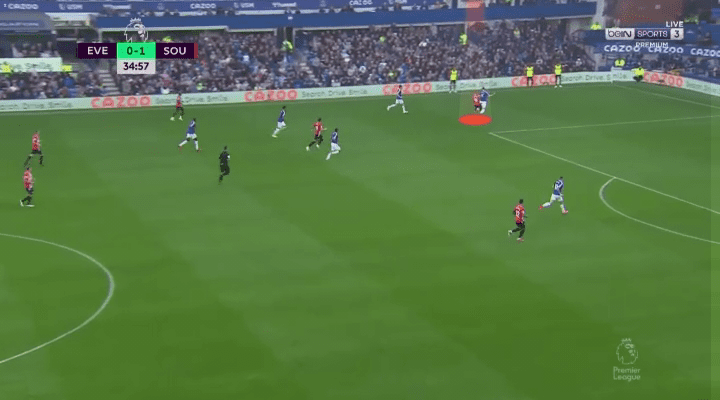
If the centre-back reached the ball first, he was likely to clear the ball to the flanks and the striker was hunting him down. If the striker reached the ball first, he needed to keep it and wait for the others to join the attack. That’s why the intensity of the run was important, as the opposition must feel the pressure for most of the time.
Intriguingly, the outcome of the example was something else. The situation was a 50-50 duel between Armstrong and the centre-back. Armstrong impressively stretched his leg to retain the ball before separating it from the defender with his body.
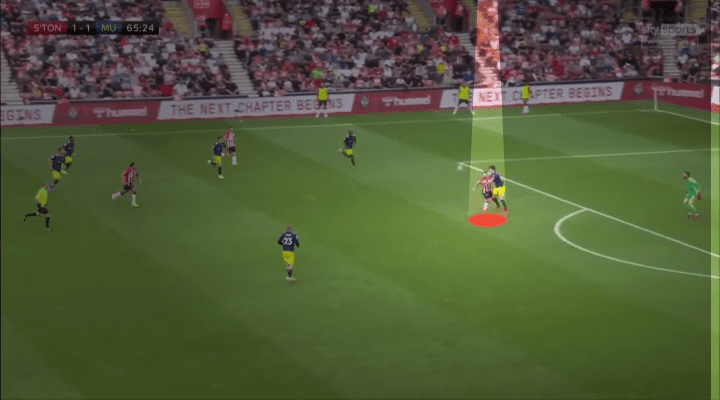
In addition, Armstrong is good at using his body to shield the ball. This example against Manchester United’s Harry Maguire was clearer. Even against more physical defenders, Armstrong always combats. In this image, we highlighted both of them.
When the ball was dropping from the air, you could see Armstrong intelligently turning his body (facing the sidelines) to separate Maguire from the space of the dropping point. Meanwhile, he stuck his right foot between Maguire and the ball. If the centre-back tried to kick the ball, he would be clashing with Armstrong, resulting in a foul.
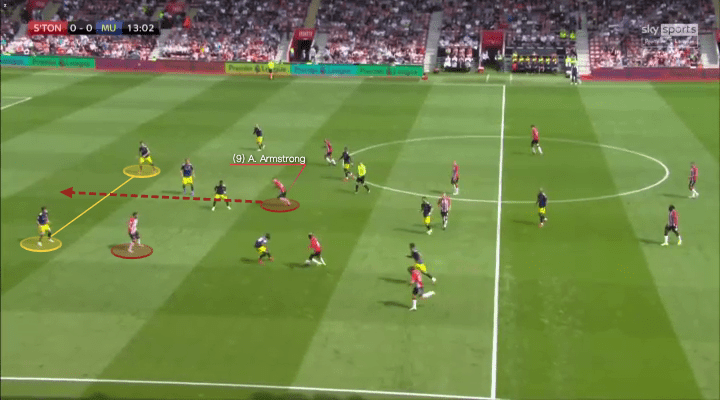
Tactically, Armstrong is a good fit for Hasenhüttl as he senses the gaps between the defence very well. The former Blackburn striker makes relentless runs into the final third. In this example against United, he spotted the run between the centre-backs and quickly dashed to offer an option behind the lines for Djenepo.
Even if Armstrong might not be receiving the ball, the run was vital as he either fixed the defender’s attention or even moved him to the centre. Then, his partner would be free in the half-spaces to receive.
This was also demonstrating his good interpretation of the game. Contrary to some previous examples in which he looked for the ball between the lines, his decision to attack spaces behind was very smart.
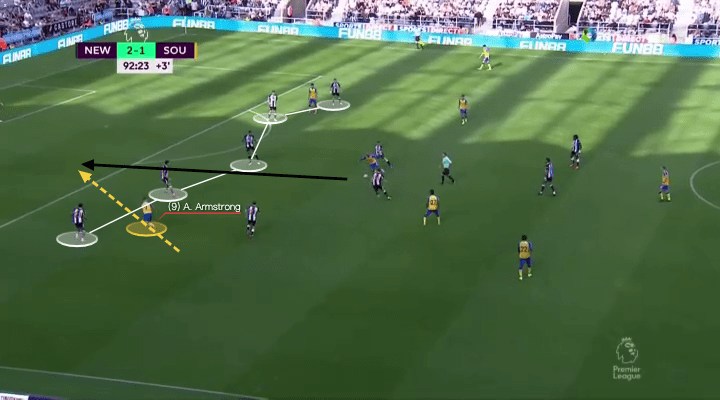
Armstrong also has a good mentality, he always shows up during deficit. Against Newcastle, when the Magpies thought they were taking all three points after a late goal, Armstrong won a penalty to secure a point for the Saints. In this image, he sharply exploited the centre-back’s blindside and attacked the gap to receive behind.
Armstrong’s runs from deep are clever. He rarely stays on the shoulder of the defence as that limits space to run and accelerate. Therefore, he tends to attack from deep to generate more space for sprints, while also keeping himself off the defender’s radar.
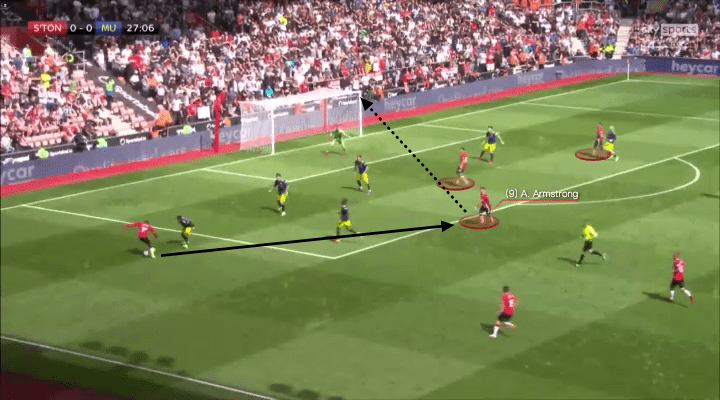
n terms of finishing, Ings is undoubtedly better. By data, Ings outperformed by scoring 12 goals from 8.25 xG in the previous season, and scored 22 goals from 15.47 xG in 2019/20. Armstrong was decent as well, he had 16 goals from 10.22 xG, and 28 from 27.97 xG in the last two campaigns. However, the rate at which Ings outperformed his xG was too good, it is difficult to match.
The last example of the section demonstrates Armstrong’s ability to find spaces from where he can shoot. On this occasion, Djenepo was dribbling on the flank with two Saints players in the penalty box who fixed the depth of the defence. Armstrong preferred to stay at the edge of the box, or specifically, red zone, to receive, so he could have spaces to adjust the ball to a better angle and shoot.
Defensive contributions
Hasenhüttl’s football is famous for its intense pressing. All players under the former RB Leipzig head coach must be able to work hard and collectively against the ball. In his limited game time, Armstrong has demonstrated his adaptability to this kind of playing style. This section analyses his defensive performance in his Premier League games.
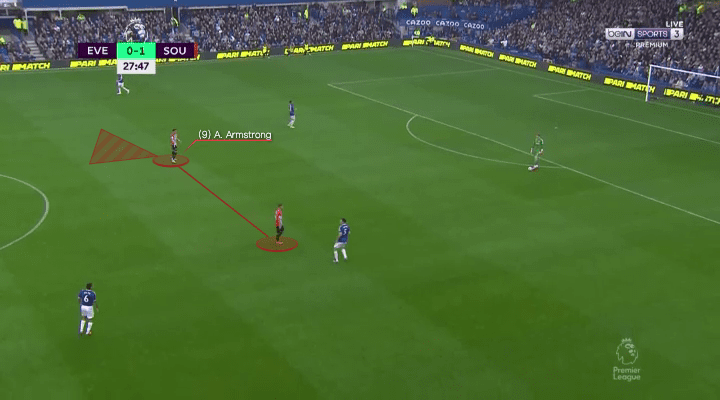
The first example of the section shows one of Southampton’s medium-high defending scenarios. Usually, Hasenhüttl’s team defends in a strict 4-2-2-2 with a pair of strikers as the first line. Armstrong has good disciplinary and tactical understanding to carry out the press.
Firstly, Jordan Pickford came out to play with the centre-backs to create a 3v2 numerical advantage for Everton. However, Pickford could not pull the strikers out, as Armstrong and Adams understood the instructions. They initially stayed in position.
Staying in position was not equivalent to standing. Armstrong impressed with his adjustments of body angle to perceive better visual information. You could see he was oriented to Pickford diagonally, so his blindside was on the smaller part of the pitch. Armstrong could easily turn his head and check the situation between his partner, such as who would be dropping to receive from the centre.
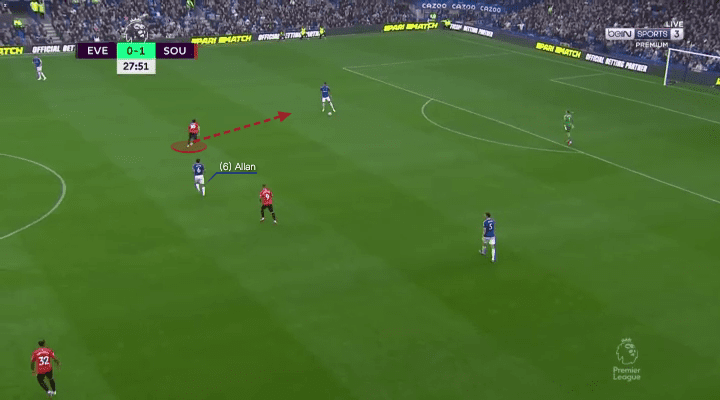
Everton did not fall into the central trap. Pickford passed to Mason Holgate, and now was the moment to press! Armstrong’s running route was good as he limited spaces for Allan to receive behind him, also with the help of Adams. Then, the Saints could force Everton sideways or long. Of course, we want to point out that the good pressing was attributed to Armstrong’s initial good body angle.
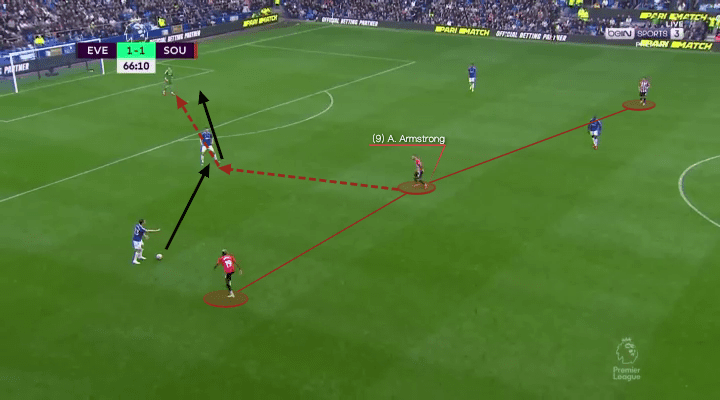
Armstrong is a very hard-working player. He would press the opposition all the way to disrupt the tempo. On this occasion, Southampton defended in a shape more similar to a 4-3-3, as Djenepo jumped up to get tighter with the right-back.
When the Toffees played the ball back, Armstrong instantly jumped onto the centre-back, then went to press the goalkeeper to force a long ball.
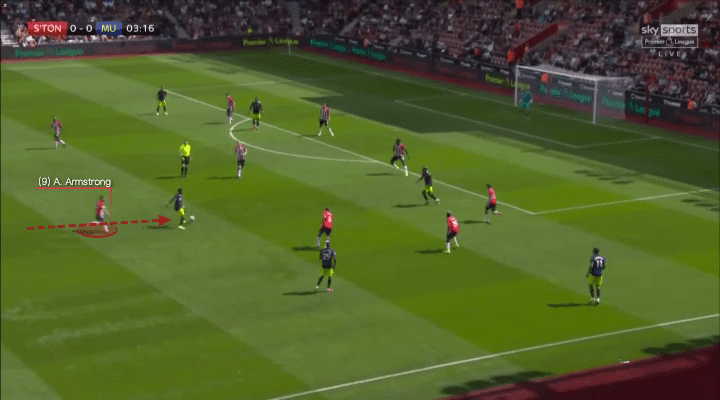
In a low block, Armstrong can also contribute by getting back to defend. This example from the United game showed Paul Pogba receiving with his back to his own goal, but Armstrong sprinted to attack the ball, which limited United’s room of play and forced them to slow down.
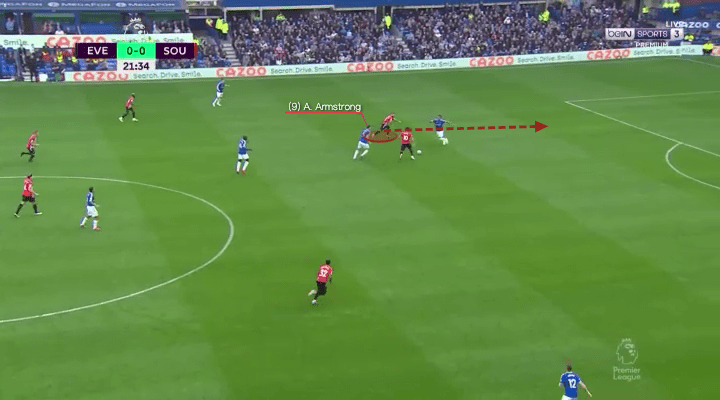
Armstrong is also a great player in the offensive transitions. Hasenhüttl requires his player to press for goals and Armstrong has the same desire in every transition move. His debut goal against Everton is a good example.
When Adams stole the ball from Michael Keane, Armstrong did not want the ball to his feet. He wanted the ball behind the defence so there would be a 1v1 chance against Pickford and he had the pace to attack spaces behind.
Armstrong shows very good non-verbal communication with teammates, as he always points to a position that indicates where the ball should go.
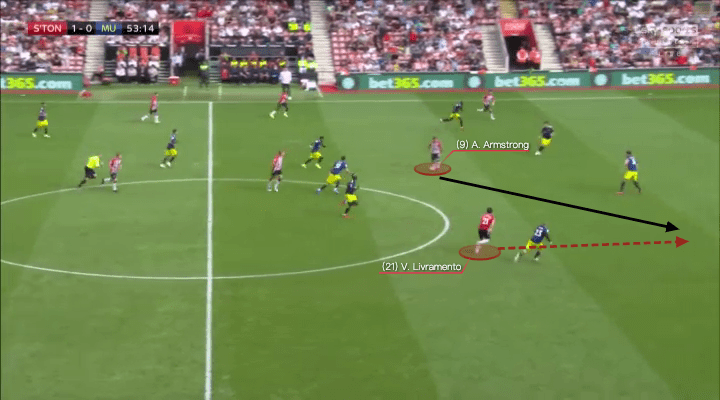
Another example here shows Armstrong has a good mindset to play quick transition football. In this example against United, he had the ball in the red zone, but now was not the time for dribbling. Hence, Armstrong spotted Tino Livramento’s run and tried a riskier pass. Although the pass was unsuccessful, the mindset was a perfect fit for Hasenhüttl’s football.
Final remarks
As our analysis has explained, Armstrong is a very dynamic player. Compared to Ings, he can integrate into more parts of the game as his physicality allows him to combat in duels. Of course, Ings is a top-class finisher who scored an incredible number of goals, and the team will suffer without him, but we believe Hasenhüttl will also come up with plans to utilise Armstrong’s strengths.

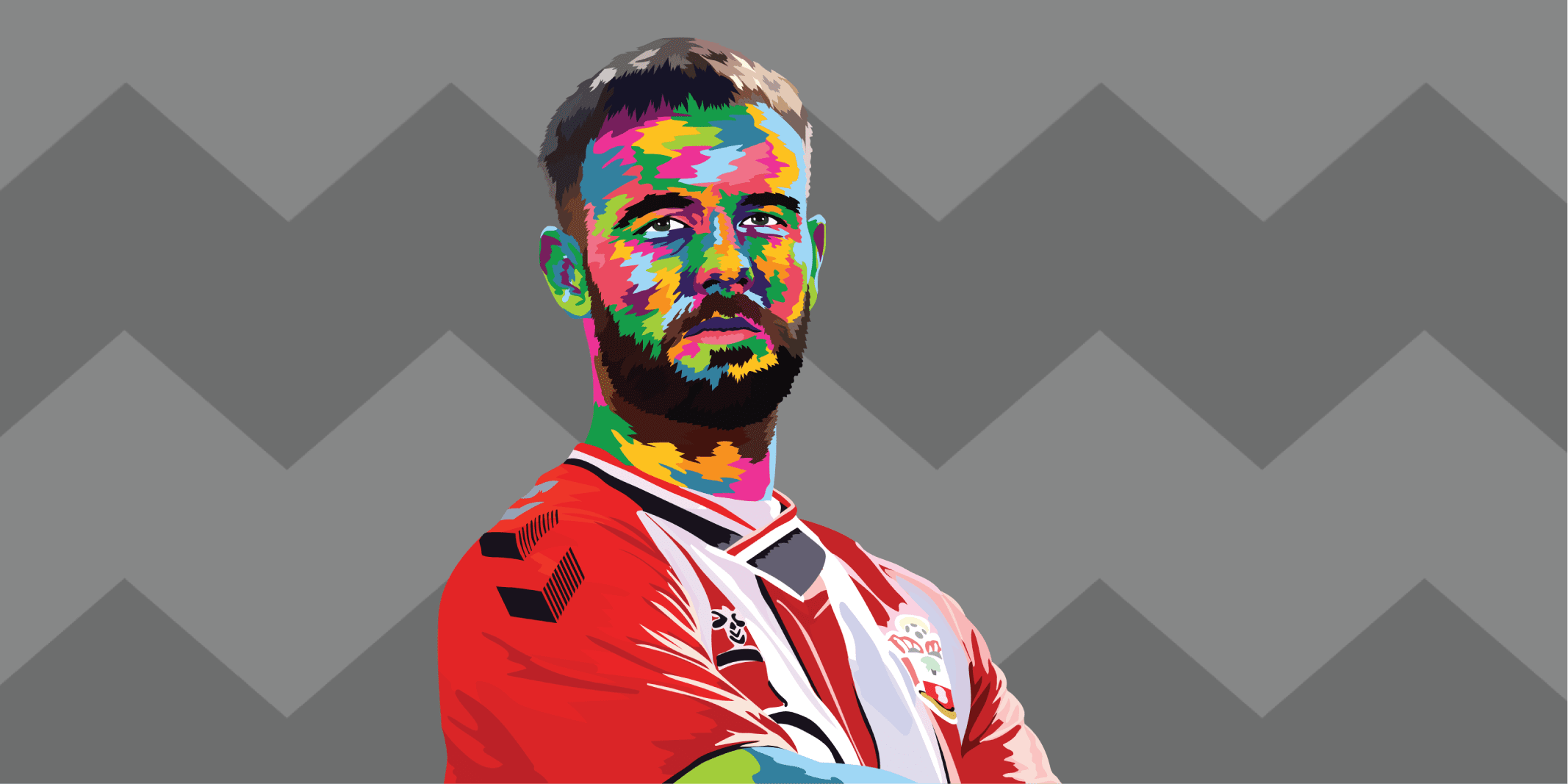



Comments